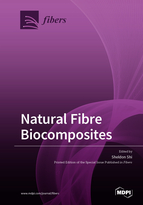Natural Fibre Biocomposites
A special issue of Fibers (ISSN 2079-6439).
Deadline for manuscript submissions: closed (31 August 2018) | Viewed by 44531
Special Issue Editor
Interests: functional natural fiber composites; biomass to carbon conversion; engineered wood products
Special Issues, Collections and Topics in MDPI journals
Special Issue Information
Dear Colleagues,
This Special Issue is designed to update state-of-the-art technologies of biodegradable natural fibercomposite products. This Special Issue will consist of (but is not limit to) the following aspects:
- Fiber retting: The technologies for the conversion of wood and bast into fibers, including mechanical retting, bacterial retting, chemical retting, and other techniques;
- Fiber property characterizations: The physical and mechanical properties of different natural fibers, including wood, kenaf, hemp, cotton, wheat straw, bamboo, sisal, flex, and others;
- Fiber treatments: 1) treatment of natural fibers to enhance the interfacial bonding of fibers and the performance of the resulting composites; 2) treatment of natural fiber for the functionalization of fiber and the resulting composites;
- Bioresins and bioadhesives: This is to focus on the technology development of biodegradable adhesives and resins, such as soy based resin, glycosyl resin, and other plant based adhesives.Composites fabrication: Processing techniques for both structural and nonstructural natural fiber composites;
- Physical and mechanical properties, including decay resistant, biodegradability, mechanical performance, physical performance (thermal, sound, and others) of natural fiber composites
- Applications, including building, transportation, automobile and aerospace, military, and others
Prof. Sheldon Shi
Guest Editor
Manuscript Submission Information
Manuscripts should be submitted online at www.mdpi.com by registering and logging in to this website. Once you are registered, click here to go to the submission form. Manuscripts can be submitted until the deadline. All submissions that pass pre-check are peer-reviewed. Accepted papers will be published continuously in the journal (as soon as accepted) and will be listed together on the special issue website. Research articles, review articles as well as short communications are invited. For planned papers, a title and short abstract (about 100 words) can be sent to the Editorial Office for announcement on this website.
Submitted manuscripts should not have been published previously, nor be under consideration for publication elsewhere (except conference proceedings papers). All manuscripts are thoroughly refereed through a single-blind peer-review process. A guide for authors and other relevant information for submission of manuscripts is available on the Instructions for Authors page. Fibers is an international peer-reviewed open access monthly journal published by MDPI.
Please visit the Instructions for Authors page before submitting a manuscript. The Article Processing Charge (APC) for publication in this open access journal is 2000 CHF (Swiss Francs). Submitted papers should be well formatted and use good English. Authors may use MDPI's English editing service prior to publication or during author revisions.
Keywords
- Natural fiber treatment
- Bioresin and bioadhesive
- Natural fiber composites fabrication
- Functional composites
- Nanoparticle






